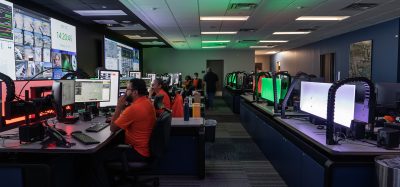Automating ATM: “Stripless” earns its spurs
Posted: 1 December 2006 | Alain Rossier, Chief Executive Officer, skyguide | No comments yet
Skyguide, Switzerland’s air navigation service provider, has achieved tangible improvements in both working comfort and ATC capacity since it adopted its new “stripless” air traffic management system in December 2005. To date, experience of the new system has been highly positive; the controllers’ enthusiasm for their new work-tool is a powerful argument for automating this part of their tasks in order to help handle ever-increasing traffic volumes.
Skyguide, Switzerland’s air navigation service provider, has achieved tangible improvements in both working comfort and ATC capacity since it adopted its new “stripless” air traffic management system in December 2005. To date, experience of the new system has been highly positive; the controllers’ enthusiasm for their new work-tool is a powerful argument for automating this part of their tasks in order to help handle ever-increasing traffic volumes.
“Only benefits”
Around 80 air traffic controllers at skyguide’s Geneva control centre have been managing the air traffic in the upper airspace of Western Switzerland and parts of neighbouring France entirely digitally – i.e. without the traditional paper control strips – since December 22, 2005. Some of the controllers involved may have had initial doubts about the new system but these have long been allayed over the intervening months. With the new approach proving not only viable and reliable but pleasant to work with, the users are now highly enthusiastic about their new working method.
If those most affected – the controllers – are the yardstick, the new approach must be deemed an out-and-out success. “There are only benefits,” says a controller who has worked at various air traffic management centres in and outside Switzerland. “Skyguide’s stripless system is also a notch above the others,” he adds. “Its conflict projection tools are revolutionary.” The new system’s conflict detection tools – the Horizontal Scanning Tool or HST and the Dynamic Scanning Tool or DST – and the electronic coordination that it provides have indeed been warmly welcomed by the skyguide controller corps.
Working comfort and safety
The new system has clearly enhanced the controllers’ working comfort by substantially reducing workload per flight movement and by improving concentration on the radar screen. “With the new system, we no longer have to scan both the strips and the screen, and we no longer have to physically move the strips,” one controller explains. “This means that we can now focus solely on the radar screen, which gives us more time to manage the traffic in our charge.”
With hindsight, the older strips may actually have been a hindrance to the controller’s work, or even a psychological handicap: at times of high traffic volumes, the pile of strips accumulated at their workplace sometimes gave the controller a sense of physical overload. The new system eliminates this hindrance, transferring all the strips’ information to the radar screen, where communications and confirmations can be effected by clicking directly on the relevant displays.
A further tangible benefit of the new stripless system can be seen in the coordination it permits between the executive controller and the planning controller: this, too, has been greatly enhanced by the electronic confirmation process.
Skyguide’s controllers are equally adamant that the gains in working comfort are enhancing safety, too – a claim that will hopefully be confirmed by more extensive experience and longer-term statistics.
Performance improvements
The improvements in working comfort have certainly translated into sizeable capacity gains. Controllers are now handling the same volumes of traffic that they handled before more easily and more quickly, enabling skyguide to substantially increase overall ATC capacity. With the controllers having now gained sufficient familiarity with the new system, capacity has been increased twice in the course of 2006 for large areas of the upper airspace concerned – by around 5 % on June 8 and by a further 5 % on September 1. The charts above of traffic volumes handled and delays incurred reflect the increases in capacity. The control centre’s capacity was estimated to be 132 flights per hour in the July 17-30 period – some 7.3 % higher than for the same period last year.
It should also be borne in mind that the new stripless system holds further potential for increasing ATC capacity: skyguide’s capacity-raising strategy is an ongoing and coordinated process.
Better coaching
Coaching is a further area in which the stripless system has delivered sizeable benefits. In introducing the new approach, skyguide has created one additional workstation for each airspace sector, for use either in the event that one of the two other workstations fails, or to perform on-the-job training. For the latter, the additional workstation enables the instructor to sit next to the trainee (rather than behind them as before) to monitor their work. At the same time, any loss of the ‘checkability’ that the old system offered in terms of the physical movement of the paper strips, is being addressed by developing a means of monitoring the trainee’s screen display. This should enable the coach to see on their own screen, and in great detail, every action the trainee performs. This new coaching tool should be available soon.
Skyguide: “a pioneer”
In view of its adoption of the stripless ATM approach, skyguide has been named as a “pioneer” by Eurocontrol’s First ATC Support Tools Implementation or FASTI programme, which is intended to harmonise the Europe-wide development and adoption of conflict detection tools, inter-sector and inter-centre coordination tools and monitoring aids. Skyguide is not only cited by Eurocontrol for its HST, DST and AMT (Adherence Monitoring Tool) facilities, but is also praised for the way that its new system has been accepted and assimilated by its controller corps.
A progressive introduction
Skyguide has indeed adopted a different approach to introduce the new stripless system from those it has used in the past to implement new technology. And, if the new system has been well accepted by the company’s controllers, this is due in no small part to its dynamic project management and to their close involvement in every step of the process. The new system was, moreover, developed from the outset from the controller’s perspective, and all its functions were co-devised by the controllers who would use them.
At the same time, to optimise the planning of the training required and maximise acceptance of the new system, skyguide adopted a step-by-step approach to introduce the new stripless system rather than the “big bang” alternative. As a result, the system’s technical development and the training of the various personnel groups involved have been conducted in successive projects or in functional groups or “batches”. It was impossible, however, to avoid the understandable discomfort during the pre-operational phase of presenting flight information both on the new displays and on the traditional physical strips.
Automation for human benefit
In terms of automating ATM, it is also important to note that the digitisation presented by the stripless system maintains a clear demarcation between man and machine in the tasks and responsibilities involved. Pivotal to the entire stripless philosophy is the fact that the approach has been specifically designed not to create any automatic functions that would hamper the controller’s own thought processes. The tools that the new system provides are not control tools but support tools. The automatic conflict detection functions, for example, only flag the potential problem; it is still the controllers who manage the traffic in their care, of which they – and only they – have an overall dynamic view, and for which they thus continue to bear full responsibility. As a result, the stripless human/machine interface is by no means part of any broader process to replace humans with machines.
To take an analogy that has been used by the controllers themselves: moving to a stripless ATM system is not unlike replacing a reading candle with a halogen lamp, or phasing out a Douglas DC-8 in favour of an Airbus A320. The activity – reading or flying – remains essentially the same; but it is considerably facilitated by the more advanced technology. The work – its responsibilities, its decision-making, its creativity and its intellectual processes – all remain firmly in the human domain, but the machine is there to assist and advise the controller through its various phases. As Professor Johannes Reichmuth of the Institute of Air Transport & Airport Research in Cologne, a member of Eurocontrol’s Performance Review Commission, put it: “Technical aids are still way behind the human mind when it comes to responding to developments and events” (Skymag No.13, Page 28). By allowing controllers to concentrate on traffic developments and events, the stripless system helps make optimum use of the core skills and functions which lie at the heart of the controller’s profession.
“Inevitable”
With the innovations it provides in terms of automating certain functions on man’s behalf, the stripless approach also offers new prospects and perspectives for pan-European projects to automate air navigation services, such as Mode S and Datalink. The latter is intended to digitise (and thus limit) radio communications between pilots and controllers, which form a large part of the controller’s overall workload and which can also be a source of errors.
The automation of ATM tools is often described as an “inevitable” development, insofar as it is the only viable response to the projected further increases in air traffic demand. This steady automation of the controller’s worktools, as is tellingly exemplified by the new stripless system, has also been embraced by skyguide’s controllers. “It’s all bound to come,” one of them concludes. And, once they have got used to the new stripless system, some of them have found it extremely frustrating to have to go “back to the old ways” – as two controllers found when they were transferred to the Geneva terminal zone sectors, where control strips continue to be used. Indeed, the controllers working in those sectors which still use control strips would also like to see the stripless system adopted, with the requisite modifications to meet terminal zone needs. Here, too, the adoption of such a system should have a sizeable impact on the capacity of the airports concerned.
Alain Rossier
Alain Rossier joined skyguide as Chief Executive Officer in spring 2001, following roles at telephone and telecommunication companies in Switzerland and the USA. His last position was Executive Vice-President of the Product House PublicCom at Swisscom.
Join our free webinar: Beyond silos: How ecosystem thinking elevates the airport experience
In today’s complex aviation landscape, airports are moving beyond siloed operations to embrace a new era of collaboration. This webinar focuses on how leading airports are using ecosystem thinking to adapt, personalize, and continuously improve every touchpoint, boosting both passenger satisfaction and non-aeronautical revenue.
Date: 13 Nov | Time: 10:00 GMT
REGISTER NOW TO SECURE YOUR SPOT
Can’t attend live? No worries – register to receive the recording post-event.

















